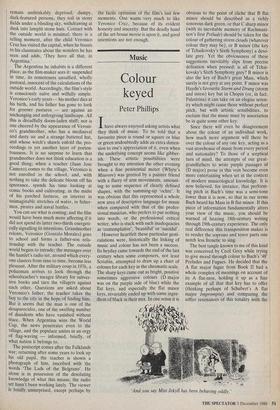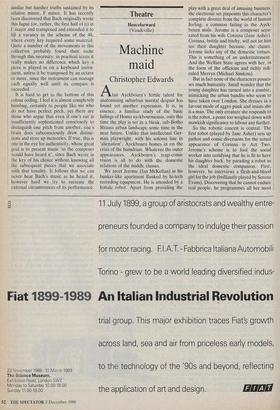Music
Colour keyed
Peter Phillips
Ihave always enjoyed asking artists what they think of music. To be told that a favourite piece is round or square or blue or green undoubtedly adds an extra dimen- sion to one's appreciation of it, even when the underlying concept seems like gibber- ish. These artistic possibilities were brought to my attention the other evening when a fine penitential motet (Whyte's Miserere) was greeted by a painter friend with a flurry of arm movements, amount- ing to some sequence of clearly defined shapes, with the summing-up 'ochre'. It was obvious that this represented a whole new area of descriptive language for music when compared with that of the profes- sional musician, who prefers to put nothing into words, or the professional critical writer, who is stuck with such inadequacies as 'contemplative', 'beautiful' or 'suicidal'.
However heartfelt these particular gesti- culations were, historically the linking of music and colour has not been a success. Its heyday came towards the end of the last century when some composers, not least Scriabin, attempted to draw up a chart of colours for each key in the chromatic scale. The sharp keys came out as bright, positive sometimes aggressive colours (D major was on the purple side of blue) while the flat keys, and especially the flat minor keys, invariably ended up with some ingre- dient of black in their mix. In one sense it is
obvious to the point of cliché that B flat minor should be described as a richly sonorous dark green, or that C sharp minor (with its inevitable memory of Rachmani- nov's first Prelude) should be taken for the colour of gathering storm clouds (whatever colour they may be), or B minor (the key of Tchaikovsky's Sixth Symphony) a deso- late grey. Yet the obviousness of these suggestions inevitably slips from precise definition when pressed: is all of Tchai - kovsky's Sixth Symphony grey? B minor is also the key of Bach's great Mass, which surely is not grey at any point. F minor was Haydn's favourite Sturm und Drang (storm and stress) key but in Chopin (or, in fact, Palestrina) it can take on an elegiac seren- ity which might cause those without perfect pitch, but with artistic sensibilities, to exclaim that the music must by association be in quite some other key.
Since there will even be disagreement about the colour of an individual work, how much more argument will there be over the colour of any one key, acting as a vast storehouse of music from every period and nationality? To those of a sceptical turn of mind, the attempts of our great- grandfathers to write purple passages of (D major) prose in this vein become even more entertaining when set in the context of modern musicological knowledge. It is now believed, for instance, that perform- ing pitch in Bach's time was a semi-tone lower than it is now, so that in our terms Bach heard his Mass in B flat minor. If this piece of information fundamentally alters your view of the music, you should be warned of hearing 18th-century writing through 19th-century experience. The only real difference this transposition makes is to render the soprano and tenor parts one notch less frenetic to sing.
The best tangle known to me of this kind was conceived by Cecil Grey while trying to give mood through colour to Bach's '48' Preludes and Fugues. He decided that the A flat major fugue from Book II had a whole complex of meanings on account of its A flat-ness, holding it up as a fine example of all that that key has to offer (thinking perhaps of Schubert's A flat major Impromptu) and comparing the softer resonances of this tonality with the And you say Miss Jekyll has been behaving oddly.' similar but harsher truths sustained by its relative minor, F minor. It has recently been discovered that Bach originally wrote this fugue (or, rather, the first half of it) in F major and transposed and extended it to fill a vacancy in the scheme of the 48, where every key required some material. Quite a number of the movements in this collect;on probably found their niche through this necessity: in practical terms it really makes no difference which key a piece is played in on a keyboard instru- ment, unless it be transposed by an octave or more, since the instrument can manage each equally well until its compass is exceeded.
It is hard to get to the bottom of this colour coding. I feel it is almost completely humbug, certainly to people like me who do not have perfect pitch, yet there are those who argue that even if one's ear is insufficiently sophisticated consciously to distinguish one pitch from another, one's brain does subconsciously draw distinc- tions and store up memories. If true, this is one in the eye for authenticity, whose great goal is to present music 'as the composer would have heard it', since Bach wrote in the key of his choice without knowing all the subsequent pieces that we associate with that tonality. It follows that we can never hear Bach's music as he heard it, however hard we try to recreate the external circumstances of its performance.



































































 Previous page
Previous page